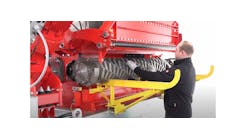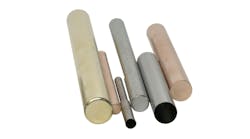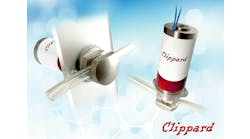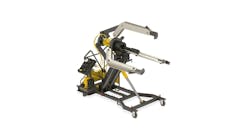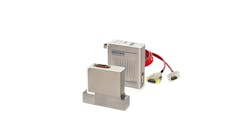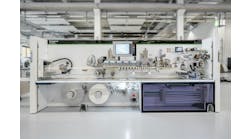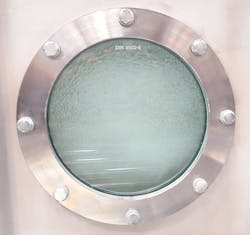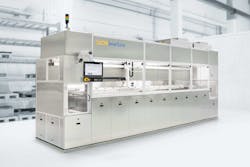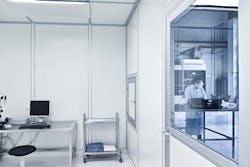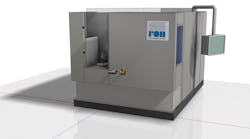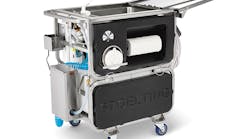Whether it's a millimeter-small fastener, complex precision optics or meter-sized machinery parts, the cleanliness requirements for high-tech components are becoming stricter and more demanding in numerous branches of industry. Although the exact specifications vary depending on the part, sector, and application, most conventional cleaning systems cannot achieve the result required to ensure consistent product quality.
Ecoclean has been supplying solutions for precision and high-purity cleaning applications for many years. With its wealth of experience, the company is constantly driving forward the development of cleaning systems, technologies, and processes for this sector, including specially-designed feature packages.
Demands on the performance and reliability of components and parts have increased enormously and continue to rise, particularly in sectors such as semiconductors, optical & optoelectronic, thin-film technology, vacuum, laser & analysis technologies, as well as the medical device industry. This has an impact on parts cleaning.
Higher Cleanliness Requirements Due to New Products and Processes
When it comes to components for semiconductor production equipment, due to new developments in wafer steppers and scanners for EUV lithography, for instance, mechanical components are not only becoming more and more complex in shape but also heavier and larger.
Today, the diameters of these workpieces can be anything from one millimeter to over one meter in size, and this range is constantly increasing. At the same time, the diversity of materials used is also rising. Additionally, specifications regarding particulate, film-type -chemical, organic and inorganic cleanliness are becoming increasingly stringent.
The situation is similar for vacuum components used in UHV, XHV, and UCV applications, such as those for high-power laser systems or high-tech measuring and analysis equipment. In the case of precision optics like mirrors, lenses, prisms and micro-optical parts, more complex geometries and modified materials are also giving rise to new and challenging cleaning tasks.
In coating technology, ever-more efficient processes call for exceptionally clean surfaces, regardless of whether parts such as machine tooling, automotive components, and optical products are cleaned before or after coating.
Needs-Based Definition of Cleanliness
For parts cleaning, this results in demanding tasks that span the entire manufacturing process. The cleanliness requirements vary depending on the product, area of application, and the company concerned.
As a rule, particulate cleanliness specifications—which extend into the nanometer range for precision and high-purity applications—are defined by surface cleanliness classes (SCC).
The specifications for the required film-type chemical, organic, and inorganic surface cleanliness are usually based on individual specifications or factory standards, for example, outgassing rates, which are evaluated by mass spectrometry. In order to solve these tasks in a needs-based, efficient, and sustainable manner, not only is comprehensive technological know-how required but also knowledge of the applications and respective physical relationships.
As an experienced full-service provider of future-oriented solutions for precision and high-purity cleaning, Ecoclean has both. This ensures cleaning solutions are designed and equipped to meet requirements, enabling defined cleanliness specifications up to the highest current requirements (for example Grade 1) to be consistently achieved.
Selecting the Right Cleaning Process and Plant Technology
Key criteria for selecting the most suitable cleaning process and plant technology are the required level of cleanliness, the type of contamination to be removed, and the material and geometry of the respective component. Based on this, it is possible to determine which and how many process steps are necessary with which cleaning medium and which mechanics.
Aspects such as the quality of the rinsing medium and the drying technology are included just as much in this consideration, as are cleanliness-compliant parts handling and the prevailing environmental conditions, for instance, connection or integration into a cleanroom.
If the standard ‘oil-free and grease-free’ such as Grade 4 is defined as the specification, Ecoclean supplies compact and cost-efficient full-vacuum single-chamber systems, whose system technology, media routing, media preparation, and design have been specially adapted for high-end cleaning applications. These systems, which are operated with environmentally-compatible solvents or water-based cleaning agents, are capable of achieving consistent results that meet such requirements, even if it concerns geometrically complex components.
Process options that can be combined in almost any way, such as injection flood washing, spray, high-pressure, immersion, ultrasonic, megasonic, and plasma cleaning, as well as Ultrasonic Plus or Pulsated Pressure Cleaning (PPC), contribute to this.
Often, a modified alcohol (partially polar solvent) is used in these applications due to the plus points associated with the media, such as their ability to clean different materials. The limit of what can be achieved with these systems is, for example, Grade 2.
Especially when it comes to large parts, chamber cleaning systems offer advantages due to the process mechanics concentrated in the working chamber, for example, PPC, ultrasonics or megasonics, and injection flood washing.
In order to use these also to meet Grade 2 or corresponding cleanliness specifications, Ecoclean manufactures EcoCvela double-chamber systems that use aqueous media for cleaning. In addition to the special high-purity features, completely separate circuits for cleaning and rinsing media ensure that the required cleaning result is achieved reliably and consistently.
If due to a wide variety of materials, high throughput requirements or cleanliness specifications corresponding to Grade 1, the cleaning tasks cannot be solved with a chamber system, a multi-bath ultrasonic cleaning system is called for.
With its UCMSmartLine or UCMPerformanceLine series consisting of standardized modules, the SBS Ecoclean Group also offers efficient solutions in this area. Thanks to the electrical and control technology integrated into the modules for the process steps of cleaning, rinsing, drying, loading & unloading, as well as a flexible transport system, these can be easily adapted to the respective task and can also be extended if necessary.
Individually-designed multi-bath ultrasonic cleaning systems such as the UCM HighLine are typically used in high-end applications, for example in the semiconductor supply, laser, and optical industries.
Processes Developed and Designed in the Test Center
Which system concept is the right one in terms of cleanliness and cost-effectiveness is determined via cleaning trials with original components or test specimens. Ecoclean has appropriate High Purity Test Centers for this purpose. As a result, product-specific cleaning processes and process parameters can be developed and then stored as programs in the system controller. This ensures that each part is cleaned with the validated process parameters to achieve the required level of cleanliness in a consistent and reproducible manner. Furthermore, all relevant process parameters can be monitored, documented, and transferred to higher-level systems.

